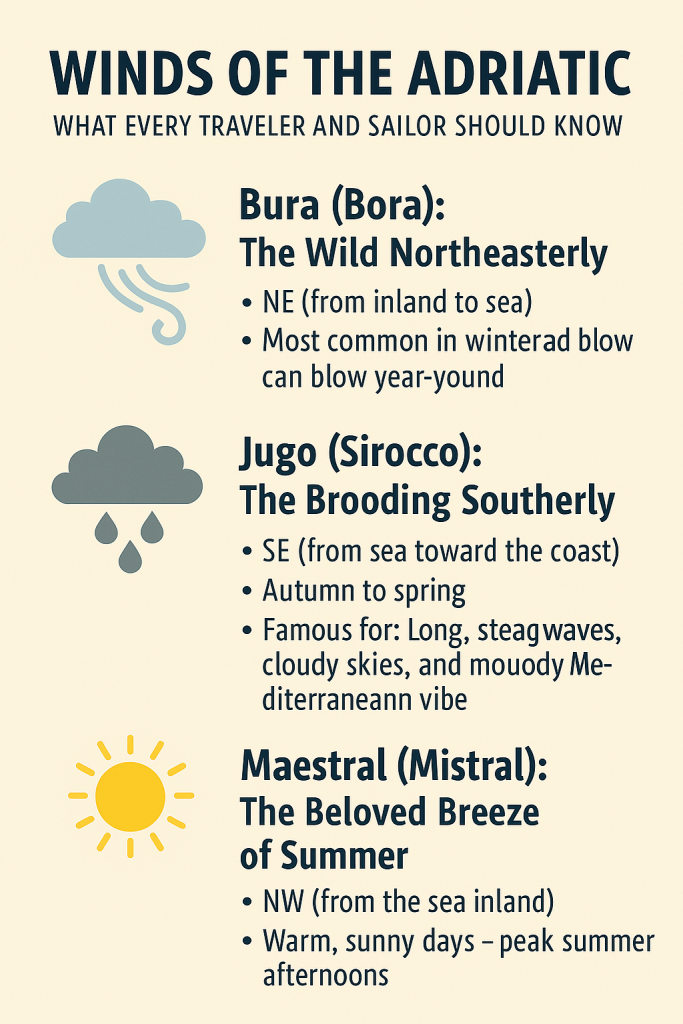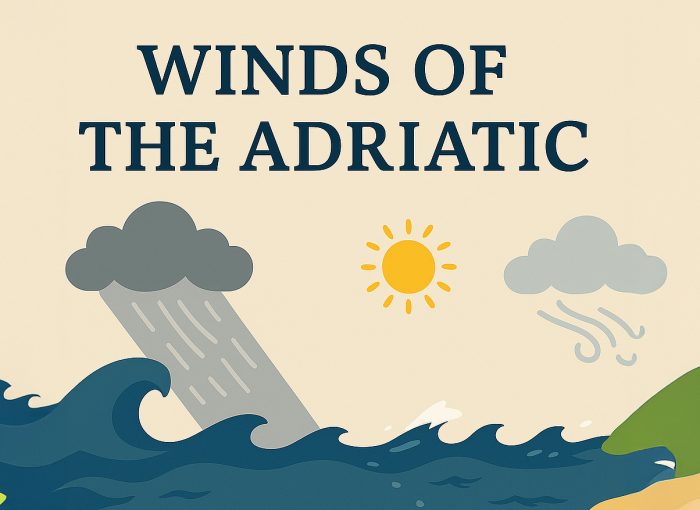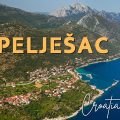From calm sea breezes to fierce mountain gusts, discover the Adriatic winds that shape travel, sailing, and life along Croatia’s coast.
The Adriatic Sea is a dreamscape of sunlit shores, sapphire waves, and charming stone towns—but it’s also a sea of winds, each with a personality of its own. For sailors, knowing the wind is second nature. But even for curious travelers, understanding these coastal breezes can enhance your trip—and keep you safe.
Table of Contents
Wind Patterns of the Adriatic
The Adriatic is shaped by two main weather types:
- Southern winds bring warm and humid air from the south side of the wind rose—these include jugo, ošto, and lebić.
- Northern winds carry cold and dry air from the north and east—most notably tramontana, bura, and sometimes levanat.
Besides these dominant winds, the Adriatic features a variety of local winds, many of which have unique regional names preserved since ancient times.
Sailors and meteorologists recognize eight main winds on the Adriatic wind rose. Starting from the north and moving clockwise, these are:
🧭 Tramontana, Bura, Levanat, Široko, Oštro, Lebić, Pulenat, and Maestral.

The two strongest winds in Croatia are:
- Bura – a northeasterly wind that blows from land to sea, cold and dry.
- Jugo – a southeasterly to southwesterly wind, warm and humid, often bringing rain.
Most ports on the eastern Adriatic coast are naturally protected from both bura and jugo—though lebić (southwesterly) often poses the greatest challenge due to its direction and force.
Let’s meet in more detail the three most important winds of the Adriatic.
🌬️ Bura (Bora): The Wild Northeasterly
- Direction: NE (from inland to sea)
- When: Most common in winter and spring, but can blow year-round
- Famous for: Sudden gusts, clear skies, and sea spray that chills your bones
The bura is the most dramatic wind on the Adriatic. It tumbles down the steep mountain slopes like a force of nature unleashed—dry, cold, and ferociously strong. One moment you’re basking in the sun, the next you’re holding your hat, squinting into a gale, and watching the sea foam with short, angry waves.
Learn more about Croatia’s fiercest coastal wind: the Bura

For tourists:
- Great for crisp, clear photography days.
- Can lower sea temperature even in summer.
- Avoid boat rides or kayaking—safety first!
For sailors:
- Known for violent gusts (up to 200 km/h!).
- Challenging to predict—watch for the “bura cap” (cloud layer over the mountains).
- Best to stay in port or sail with extreme caution.
🌊 Jugo: The Brooding Southerly
- Direction: SE (from sea toward the coast)
- When: Autumn to spring, often ahead of storms
- Famous for: Long, steady waves, cloudy skies, and that moody Mediterranean vibe

The jugo is warm and humid, often bringing with it heavy clouds and a sleepy, melancholic atmosphere. Locals say it “gets into your bones”—not just because of the drizzle, but because it can actually affect moods and energy. It’s the opposite of bura: slow-building, persistent, and emotional.
For tourists:
- Expect gray skies, soft light, and waves lapping gently at the shore.
- Watch out for motion sickness on ferries—it creates long, rolling swells.
- Ideal time for stormy sea photography or cozying up in a stone cottage.
For sailors:
- Predictable but powerful over time.
- Creates long-distance waves—great for seasoned sailors, tricky for smaller boats.
- Check barometer pressure—a drop means it’s building.
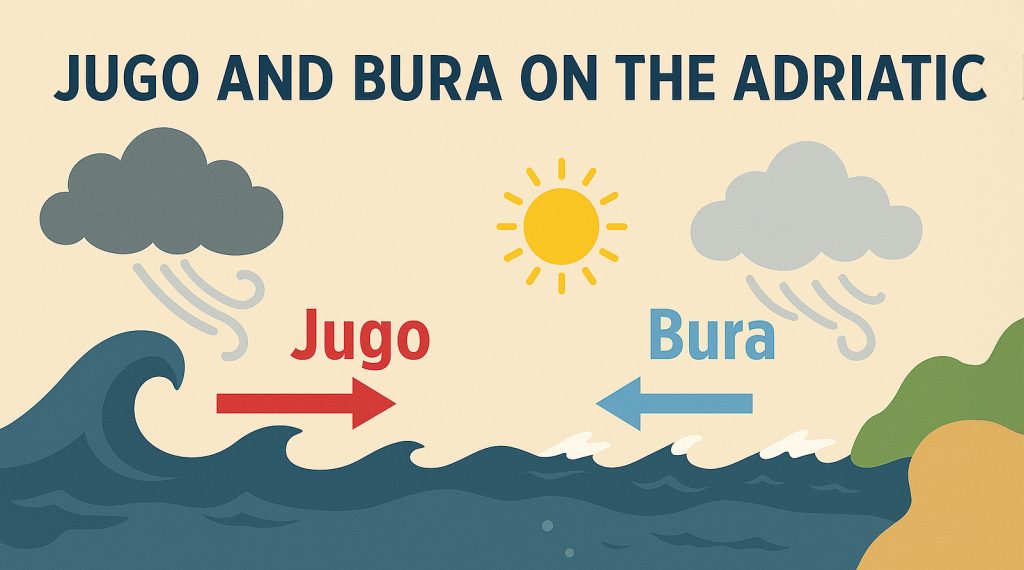
💨 Maestral (Mistral): The Beloved Breeze of Summer
- Direction: NW (from the sea inland)
- When: Warm, sunny days—peak summer afternoons
- Famous for: Cooling relief, perfect sailing conditions, and pure Mediterranean joy
The maestral is every sailor’s favorite. It usually kicks in after noon and fades by sunset, making it perfect for leisurely day sailing. Locals welcome it with open arms in the peak of summer—it keeps the air fresh and the sea playful but safe.

For tourists:
- Expect blue skies, a gentle breeze, and that perfect salty scent in the air.
- Ideal time for swimming, beach days, and boat tours.
- Windsurfers and kite surfers love it!
For sailors:
- Reliable and friendly.
- Best for beginners and relaxed cruising.
- Still, check for sudden changes—weather can always surprise.
Day and Night Winds on the Adriatic: Burin and Zmorac
During stable summer weather, when skies are clear and the sea is calm, the Adriatic experiences a gentle daily rhythm of winds known as coastal air circulation. These winds shift between day and night, offering a natural pattern of cooling that locals have trusted for centuries.
🌬️ Burin (also called kopnenjak) is a light night breeze that flows from land to sea. It begins in the late evening and often lasts until early morning. This wind forms because the land cools more quickly than the sea at night, causing colder air to move seaward. Its name comes from the Venetian “borin,” a diminutive of “bora” (bura).

🌊 Zmorac (or smorac) is a gentle daytime sea breeze that starts mid to late morning, blowing from the sea toward land. It develops when the land heats up faster than the sea, drawing in cooler marine air. On the eastern Adriatic coast, zmorac is common in calm weather—especially in open areas where islands don’t block its flow.
- It often begins as a light southeasterly, shifts to south or southwest by afternoon, and fades in the evening as a northwesterly.
- Zmorac is strongest in early afternoon, when the temperature difference between land and sea peaks.
- Though often confused with the maestral, zmorac is weaker, but just as refreshing.
For beachgoers and boaters, this natural daily wind cycle brings relief from summer heat and a pleasant rhythm to Adriatic days.
Summer Storms on the Adriatic (Nevera / Neverin)
Though summer on the Adriatic is mostly sunny and calm, sudden short storms—known locally as nevera or neverin—can sweep in with dramatic force. These brief but intense tempests often bring strong, gusty winds, thunder and lightning, and at times torrential rain that can drench the coast in minutes.
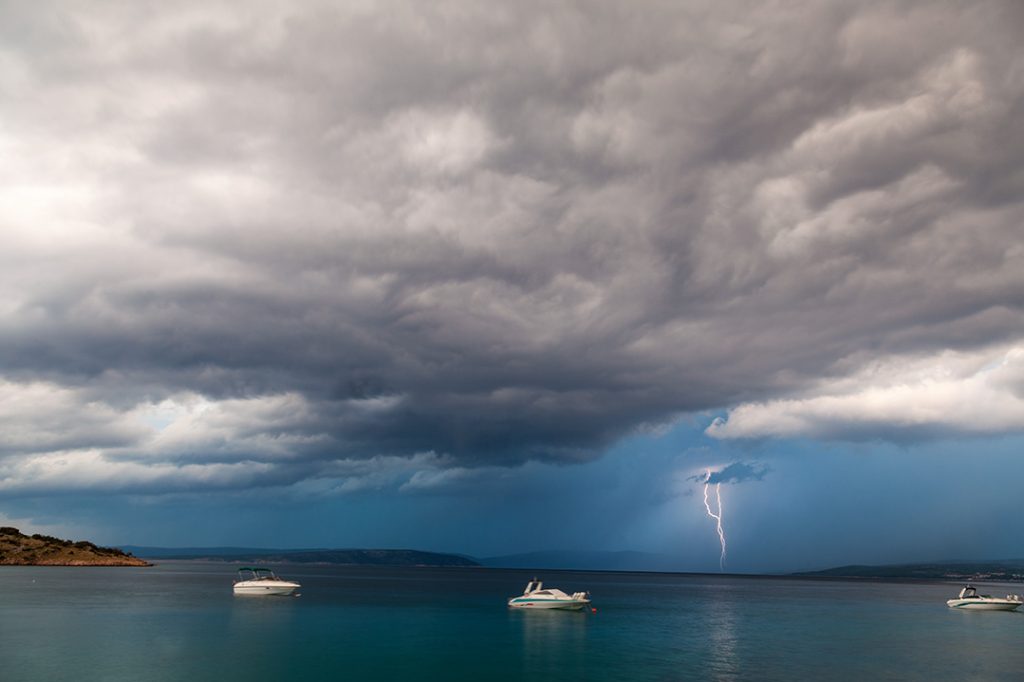
They tend to form quickly, especially in the late afternoon or evening, and vanish just as fast—leaving behind refreshed air and glowing post-storm skies. For travelers and sailors, it’s wise to always check the forecast, even on clear days, and seek shelter when the sky starts to darken.
⚠️ Bonus Wind Tips for Travelers & Sailors
- Always check the marine weather forecast (especially the Beaufort scale).
- Keep an eye on local flags—Croatians raise red or orange alerts when winds get serious.
- Watch for cloud signs: a bura cap over the mountains, heavy cloud buildup for jugo.
- Even in summer, pack a windbreaker—you might need it on a bura day.
🧭 In the Adriatic, the Winds Tell the Story
Whether you’re sailing from island to island, lounging on a beach in Dalmatia, or snapping windswept shots of a stone village high on the cliffs, the winds of the Adriatic are your invisible companions.
They shape the sea, the land, and the lifestyle—so let them guide you, cool you, and maybe even challenge you. After all, there’s no Croatian adventure quite like one carried on the wind.
